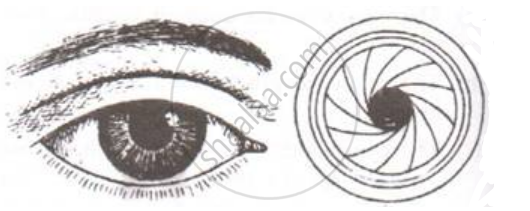Advertisements
Advertisements
प्रश्न
Name the capacity of the eye lens to change its focal length as per need.
Write the name.
The ability of lens to adjust the focal length as per need is:
उत्तर
The capacity of the eye lens to change its focal length as per need is called accommodation.
संबंधित प्रश्न
Explain the following:
Mechanism of generation of light-induced impulse in the retina.
Which. of the following has normal vision?
(a) Xc Xc
(b) Xc Y
(c) XC Xc
(d) Xc Yc
Myopia is an example of ______.
Explain why the image distance in the eye does not change when we change the distance of an object from the eye?
A person got his eyes tested by an optician. The prescription for the spectacle lenses to be made reads :
Left eye : +2.50 D
Right eye : +2.00 D
State whether these lenses are thicker in the middle or at the edges.
What job does the pupil of the eye do?
Name that part of the eye which is equivalent to the photographic film in a camera.
What is the:
far point of a normal human eye?
Give the scientific names of the following parts of the eye:
carries signals from an eye to the brain.
Give the scientific names of the following parts of the eye:
changes shape to focus a picture on the retina.
Fill in the following blank with suitable word:
The iris controls the amount of................entering the eye.
Fill in the following blank with suitable word:
To bring light from a distant object to a focus on the retina of the eye, the convex eye-lens needs to be made..........
What change is made in the eye to enable it to focus on objects situated at different distances? Illustrate your answer with the help of diagrams.
There are two types of light-sensitive cells in the human eye:
Where are they found?
The descriptions of five kinds of images are given below:
(a) diminished and virtual
(b) enlarged and real
(c) enlarged and erect
(d) real and inverted
(e) virtual and the same size
Which one of these describes the image formed:
(i) on the retina of the eye?
(ii) by a magnifying glass?
(iii) by a convex driving mirror on a car?
(iv) by a plane mirror?
(v) on the screen of a slide projector?
An object is moved closer to an eye. What changes must take place in the eye in order to keep the image in sharp focus?
What is presbyopia? Write two causes of this defect. Name the type of lens which can be used to correct presbyopia.
Which of the following have a wider field of view?
(a) Animals having two eyes on the opposite sides of their head.
(b) Animals having two eyes at the front of their head.
With both eyes open, a person's field of view is about:
(a) 90°
(b) 150°
(c) 180°
(d) 360°
With reference to the functioning of the eye, answer the question that follow:
What is the shape of the lens during near vision?
Choose the correct answer.
Rods are receptor of ______________
The figure below compares a part of our eye with a part of a photographic camera.

Explain the mode of working and the functions of the parts of the eye mentioned above.
Draw a diagram of the human eye as seen in a vertical section and label the parts which suit the following descriptions relating to the:
(i) photosensitive layer of the eye.
(ii) structure which is responsible for holding the eye lens in its position.
(iii) structure which maintains the shape of the eyeball and the area of no vision.
(iv) anterior chamber seen in front of the eye lens.
(v) outermost transparent layer seen in front of the eyeball.
Draw a labeled diagram of the front view of human eye.
Explain the Term: Accommodation in the eye
Mention, if the following statement is True or False
Cones are the receptor cells in the retina of the eye sensitive to dim light.
Mention, if the following statement is True or False
The least distance of distinct vision for the human eye is 25 cm
State the Location:
Iris
State the Function:
Cornea
Complete the following sentence with appropriate Word
The part of the human eye where rod cells and cone cells are located is the:
______ is tough and thick white sheath that protects the inner parts of the eye.
The black opening between the aqueous humour and the lens is called ____________.
Which of the following statements is correct regarding rods and cones in the human eye?
Name the part of the eye which gives colour to the eyes.
Eyes of the nocturnal birds have large cornea and a large pupil. How does this structure help them?
What kind of lens is there in our eyes? Where does it form the image of an object?
With neat, labeled diagram describe the structure of retina of eye.
Match the following:
| Column - I | Column - II | ||
| 1 | Retina | a | pathway of light |
| 2 | Pupil | b |
far point comes closer |
| 3 | Ciliary muscles | c |
near point moves away |
| 4 | Myopia | d | screen of the eye |
| 5 | Hypermetropia | e | power of accommodation |
Which of the following is responsible for the adjustment of the size of pupil?
The thin, transparent extension of sclerotic layer found in front of the lens is ______.
